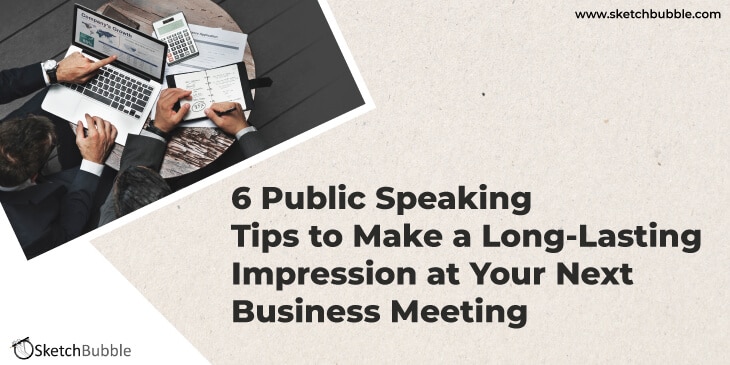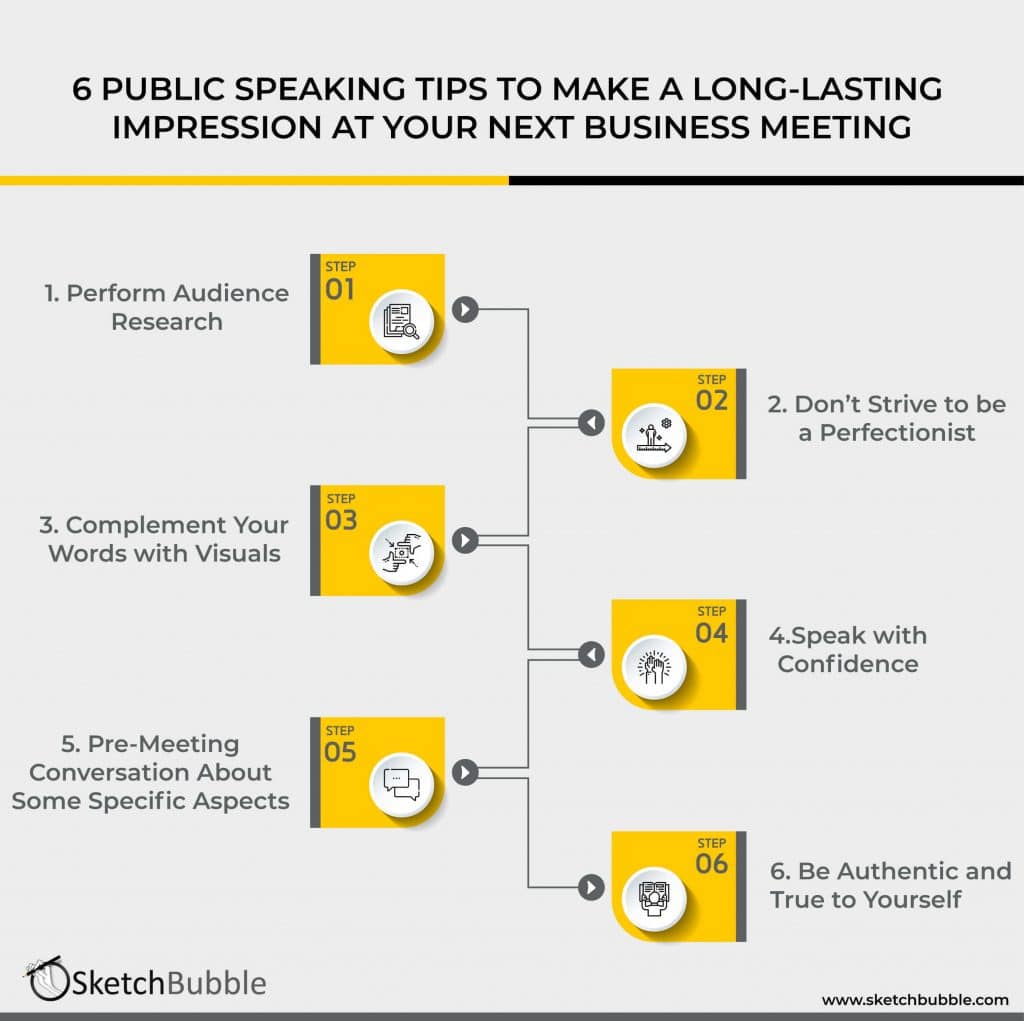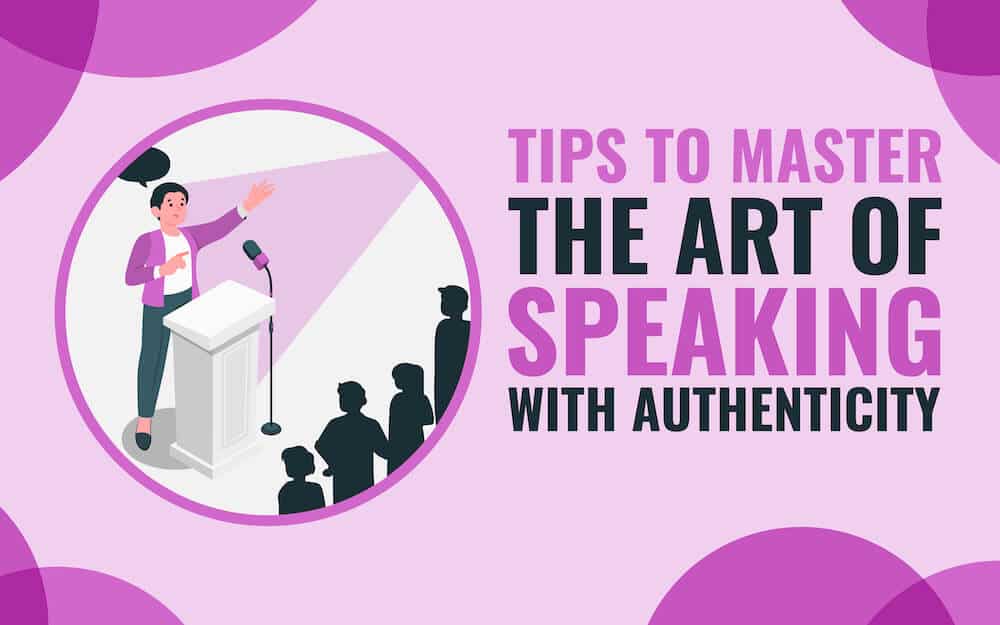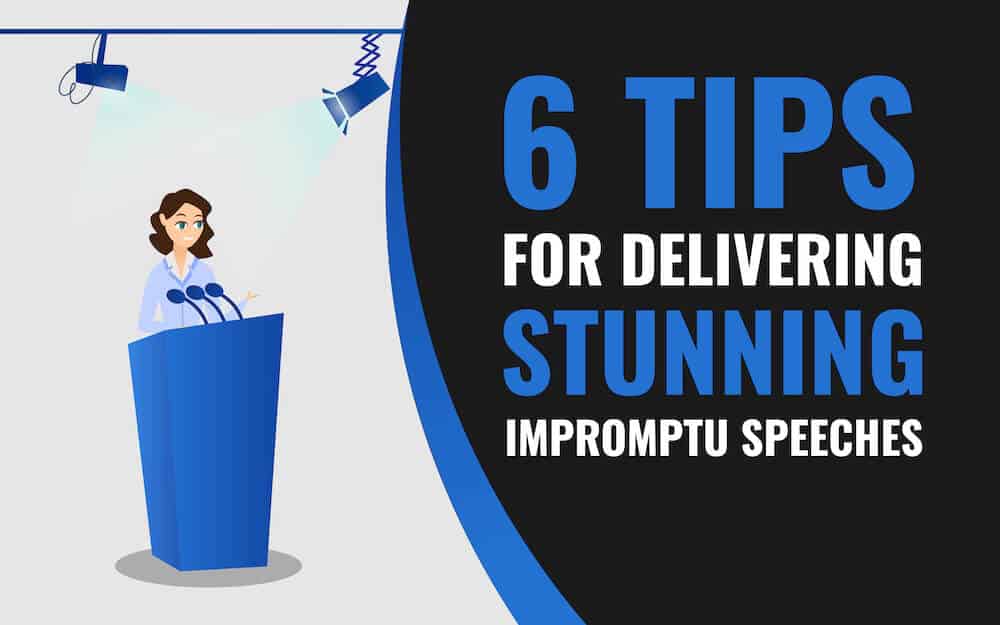6 Public Speaking Tips to Make a Long-Lasting Impression at Your Next Business Meeting

Are you one among those who feel intimidated and overwhelmed by getting an email regarding an invitation to a business meeting? If so, you are not alone! Business meetings, be it face-to-face or virtual, are really taxing for people who feel their ideas are half-baked and won’t be considered valuable by other people or who are new to the company and feel reserved around their senior colleagues/new team members. Whatever the reason is for not speaking up at business meetings, you must understand that these meetings are a critical opportunity to showcase your worth, contribute your ideas, and build your reputation. You may miss out on promotion opportunities if you choose to stay quiet in meetings.
In this blog post, we have provided you with a few public speaking tips to calm your nerves while presenting at a business meeting. Take a look!
1. Perform Audience Research
Who is going to attend the meeting? What is the purpose of the meeting? What are the educational level and subject matter knowledge of the audience who are likely to attend the meeting? This analysis will help you understand what they know and what they are required to know. Also, know whether you are supposed to make a particular recommendation or serve as an analyst (conduct research and present the facts) to support a management decision. It will also help you put across your ideas (recommendations, subject matter, proposal) in the most appropriate manner.
2. Don’t Strive to be a Perfectionist
If you genuinely want to overcome the fear of speaking at meetings, don’t set unrealistically high standards for yourself. Don’t feel shy to put across your ideas that are not well-formulated as they have a lot of value.
No idea for a new growth business ever comes fully-shaped. When it emerges, it’s half-baked, and it then goes through a process of becoming fully shaped. – Clayton M.
If you present a finished idea, people in the meeting room will probably refrain from giving you advice, but when you present a half-baked idea, they will give their honest feedback to make it more refined. Further, people will let you know their assumptions about your idea and give you a new focus. Their assumptions will also give you an understanding of the mental framework that your colleagues use to interpret your idea.
3. Complement Your Words with Visuals
The quality of content reflects your thoughtfulness and knowledge. Visuals, on the other hand, give a unique voice to your compelling message. By combining these two, i.e, text and high-resolution graphics, in your presentations, you can impress your colleagues and seniors, making a huge difference as a presenter. In this context, the following quote fits the best.
We are visual creatures. When you doodle an image that captures the essence of an idea, you not only remember it, but you also help other people understand and act on it – which is generally the point of meetings in the first place. – Tom Wujec
To summarize, visuals quickly grab the attention of the audience and get them to listen to what you are saying. Moreover, you can add a touch of relevancy and professionalism to your presentations by incorporating graphs, images, videos, charts, infographics, and tables.
4. Speak with Confidence
You can sound confident, speak with clarity, and compel other people to listen to you only if you yourself believe in your idea. So, don’t assume that your ideas/thoughts/views are wrong if they are contrary to the views of others. So, don’t hesitate to speak your mind.
“Harnessing the power of the mind-body connection means that you can learn to use your thoughts to positively influence your body’s physical responses.” – Darlene Price
Pro Tips:
- Avoid sloppy vocal habits or filler words, such as ‘umms,’ ‘you know,’ ‘okay,’ etc.
- You can project confidence through appropriate body language and gestures.
- Dress appropriately (wear the formal dress that makes you feel comfortable).
- Take pause wherever required.
- Vary your pace and tone according to the content.
- Learn from others who communicate well in meetings – listen to their volume and tonality and watch their body language. Pick the best elements from their presentations that garner positive responses from the audience, and try to incorporate them in your presentation.
Watch this TED Talk by Amy Cuddy, an American social psychologist, to get a better understanding of ‘power posing.’
5. Pre-Meeting Conversation About Some Specific Aspects
If you have an opinion about some particular aspect of the agenda that you want to share with others in the meeting, it is better to discuss it in advance with someone who will be joining the meeting. You will get two benefits of this pre-conversation – firstly, you can boost your confidence, and secondly, it will encourage the person (with whom you discussed your perspective) to “call on you” during the meeting.
6. Be Authentic and True to Yourself
You can represent yourself as an authentic speaker only if your words, behaviors, and actions are in sync with your core identity and you have no fear of rejection. Don’t underestimate your ideas, assuming that they are less valid than the ideas of others in the meeting. Don’t adjust your opinions to suit the requirements of others.

The Inference
Breaking into a cold sweat and feeling butterflies in the stomach are quite obvious before meetings, specifically when you are supposed to speak up on a topic/matter that is crucial to the business. However, you can elevate your visibility at work, make an impact, and get the recognition you deserve by overcoming the feelings of dread and coping with the anxiety of speaking your mind in business meetings. So, don’t choose to sit frozen; instead, develop public speaking skills ahead of time to ace your business meetings.
Do you have some more tips to share with us? We would like to hear from you! Do share your thoughts with us in the “Comment” section below. Also, share this blog post on your social media channels to enlighten your colleagues and friends.



